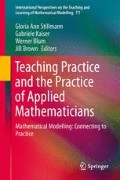Abstract
The modelling cycle (e.g., Blum and Leiß How do students and teachers deal with modelling problems? In: Haines C, Galbraith P, Blum W, Khan S (eds) Mathematical modelling (ICTMA12): education, engineering and economics. Horwood, Chichester, pp 222–231, 2007) contains the repeated processes that modellers are asked for in deepening their thinking. When we investigate the modelling cycle of modellers, we have to consider the diversities of various modellers in their modelling progress (Blum and Borromeo Ferri J Math Model Appl 1(1):45–58, 2009). In addition, problems or tasks can be changed from the initial real situation and problem with the aim of meeting the need of modellers. In this chapter, we make two modelling cycles parallel and focus on interactions between cycles, and call it the dual modelling cycle. We show three types of modelling cycles based on the dual modelling cycle framework through the example of one modelling cycle based on an Oil Tank Task, and another modelling cycle based on a Toilet Paper Tube Task.
Access this chapter
Tax calculation will be finalised at checkout
Purchases are for personal use only
References
Blum, W., & Leiß, D. (2007). How do students and teachers deal with modelling problems? In C. Haines, P. Galbraith, W. Blum, & S. Khan (Eds.), Mathematical modelling (ICTMA12): Education, engineering and economics (pp. 222–231). Chichester: Horwood.
Blum, W., & Borromeo Ferri, R. (2009). Mathematical modelling: Can it be taught and learnt? Journal of Mathematical Modelling and Application, 1(1), 45–58.
Borromeo Ferri, R. (2007). Modelling problems from a cognitive perspective. In C. Haines, P. Galbraith, W. Blum, & S. Khan (Eds.), Mathematical modelling (ICTMA12): Education, engineering and economics (pp. 260–270). Chichester: Horwood.
Kawakami, T., Saeki, A., & Matsuzaki, A. (2012). Necessity for modelling teaching corresponding to diversities: Experimental lessons based on dual modelling cycle framework for the 5th grade pupils. In ICME-12 pre-proceedings (pp. 3291–3300). Seoul: ICME.
Matsuzaki, A. (2007). How might we share models through cooperative mathematical modelling? Focus on situations based on individual experiences. In W. Blum, P. Galbraith, H.-W. Henn, & M. Niss (Eds.), Modelling and applications in mathematics education: The 14th ICMI study (pp. 357–364). New York: Springer.
Matsuzaki, A. (2011). Using response analysis mapping to display modellers’ mathematical modelling progress. In G. Kaiser, W. Blum, R. Borromeo Ferri, & G. Stillman (Eds.), Trends in teaching and learning of mathematical modelling: ICTMA14 (pp. 499–507). New York: Springer.
Matsuzaki, A., & Saeki, A. (2013). Evidence of a Dual Modelling Cycle: Through a Teaching Practice Example for Pre-service Teachers. In G. Stillman, G. Kaiser, W. Blum, & J. Brown (Eds.), Teaching mathematical modelling: Connecting to research and practice (pp. 195–205). New York: Springer.
Polya, G. (1988). How to solve it: A new aspect of mathematical method (1st Princeton Science Library ed.). Princeton: Princeton University Press.
Stillman, G. (1996). Mathematical processing and cognitive demand in problem solving. Mathematics Education Research Journal, 8(2), 174–197.
Stillman, G., & Galbraith, P. (1998). Applying mathematics with real world connections: Metacognitive characteristics of secondary students. Educational Studies in Mathematics, 36(2), 157–195.
Acknowledgement
Mr. Kurokawa Hiroshi (Tokushima office, Nisshinbo Holdings Inc.) allowed us to measure a heavy oil tank and introduced the staff concerned. Mr. Kurebayashi Yutaka (Tokai Seishi Kogyo Co., LTD.) gave us a factory tour and explained the process of making the toilet paper tube. Mr. Kainuma Kenji (Anan office, Asahi Synchrotech Corporation) provided important plan data of the heavy oil tank. Thanks to all concerned.
Author information
Authors and Affiliations
Corresponding author
Editor information
Editors and Affiliations
Rights and permissions
Copyright information
© 2013 Springer Science+Business Media Dordrecht
About this chapter
Cite this chapter
Saeki, A., Matsuzaki, A. (2013). Dual Modelling Cycle Framework for Responding to the Diversities of Modellers. In: Stillman, G., Kaiser, G., Blum, W., Brown, J. (eds) Teaching Mathematical Modelling: Connecting to Research and Practice. International Perspectives on the Teaching and Learning of Mathematical Modelling. Springer, Dordrecht. https://doi.org/10.1007/978-94-007-6540-5_7
Download citation
DOI: https://doi.org/10.1007/978-94-007-6540-5_7
Published:
Publisher Name: Springer, Dordrecht
Print ISBN: 978-94-007-6539-9
Online ISBN: 978-94-007-6540-5
eBook Packages: Humanities, Social Sciences and LawEducation (R0)

